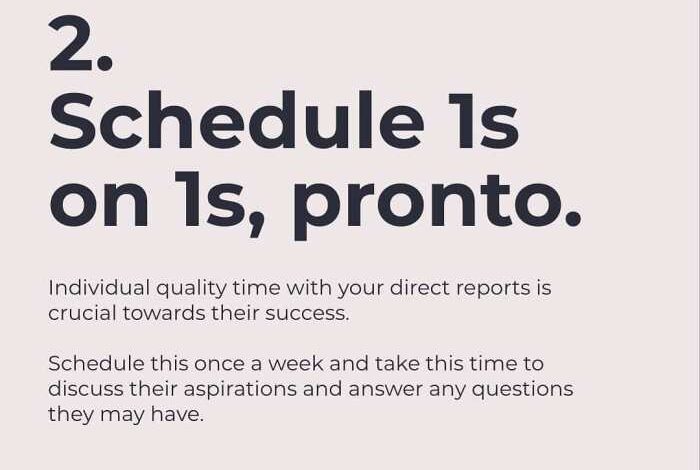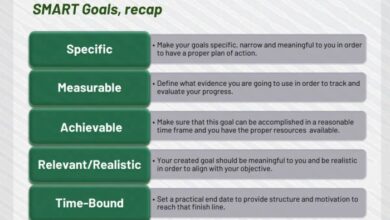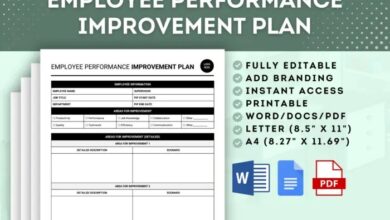
First time manager mistakes to avoid are common pitfalls that can derail a new manager’s success. Navigating the transition from individual contributor to leader often presents unique challenges. This guide explores the common errors, from communication breakdowns to delegation missteps, offering actionable strategies to help new managers avoid these common stumbling blocks and excel in their roles.
This comprehensive guide will delve into nine crucial areas of management, highlighting the key expectations, realities, and common mistakes. We’ll cover everything from effective communication and delegation to setting clear expectations, managing performance, building strong relationships, and mastering time management. Learning how to handle difficult situations and prioritize continuous learning will also be discussed.
Introduction to First-Time Management

Stepping into the role of a manager is a significant transition, moving from individual contributor to team leader. This transition often involves a steep learning curve, demanding new skills and responsibilities. New managers face unique challenges, and understanding these hurdles is crucial for navigating this shift successfully.The journey from individual contributor to manager is not simply an advancement in title; it’s a profound change in perspective and approach.
You’re no longer solely focused on your own tasks but on the performance and well-being of a team. This shift requires a deep understanding of team dynamics, effective communication, and delegation. Understanding the expectations and realities of the role is the first step toward successful management.
Defining First-Time Management
First-time management encompasses the initial period of assuming a managerial role. This phase is characterized by learning and adapting to new responsibilities, understanding the complexities of team leadership, and developing effective strategies for team performance. It often involves a significant learning curve and a shift in mindset from individual goals to collective objectives.
Unique Challenges Faced by New Managers
New managers often grapple with a variety of challenges. They may struggle with delegation, time management, conflict resolution, and communication with their team members. The transition from individual contributor to manager is often accompanied by a significant increase in workload and responsibilities. Furthermore, the need to develop leadership skills and foster a positive team environment can be overwhelming for new managers.
These difficulties are often compounded by the need to simultaneously maintain individual productivity and responsibilities.
Understanding the Transition from Individual Contributor to Manager
Effectively transitioning from an individual contributor to a manager necessitates a shift in focus. This transition demands developing new skills such as delegation, feedback delivery, and strategic thinking. Understanding the different perspectives, needs, and motivations of your team members is crucial. A key aspect of this transition is adopting a coaching and mentorship style rather than a direct instruction method.
This change in approach requires a shift in mindset and the ability to adapt to the needs of the team.
Common Expectations and Realities of the Role
The table below highlights the common expectations and realities of the first-time management role. This comparison is intended to illustrate the potential discrepancies and challenges that often arise.
| Expectation | Reality |
|---|---|
| Managing a team effectively and efficiently. | Balancing team needs with individual priorities and workload. This often requires prioritization and strategic delegation. |
| Providing clear direction and expectations. | Adapting to the diverse needs and preferences of team members, requiring a personalized approach. |
| Being a strong decision-maker. | Making informed decisions under pressure, considering the potential impact on the team. |
| Leading by example. | Modeling desired behaviors while simultaneously acknowledging and accommodating different working styles. |
| Creating a positive work environment. | Navigating interpersonal dynamics and conflicts constructively. |
Communication Errors
Stepping into management for the first time can be exhilarating, but also nerve-wracking. One of the most critical areas for success is effective communication. Misunderstandings, misinterpretations, and ineffective feedback loops can quickly erode trust and productivity within a team. This section delves into common communication pitfalls and strategies for navigating them effectively.Effective communication isn’t just about conveying information; it’s about fostering a shared understanding and a collaborative environment.
Avoiding common first-time manager mistakes is crucial for success. One key area is micromanaging – letting go and trusting your team is essential. Also, remembering that social media platform issues, like Twitter’s recent forced follow flaw fix purges of user fan files, like this recent incident , highlight the importance of clear communication and transparency in all aspects of management, not just within the workplace.
Building strong relationships and effective communication strategies are vital for leading teams successfully.
It’s about listening as much as speaking, and delivering feedback in a way that motivates and improves performance, not demoralizes. Mastering this skill is crucial for building a high-performing team.
Common Communication Pitfalls for First-Time Managers
First-time managers often fall into traps regarding communication. This can stem from a lack of experience and confidence, leading to hesitation or an overly directive approach. Some common pitfalls include: failing to actively listen, providing vague or judgmental feedback, and using jargon or overly technical language that confuses team members.
Effective vs. Ineffective Communication Styles
Effective communication styles are characterized by clarity, empathy, and active listening. Ineffective styles often involve interrupting, dominating conversations, and failing to acknowledge others’ perspectives. These differences significantly impact team dynamics, as will be explored later.
Strategies for Active Listening
Active listening is a crucial aspect of effective communication. It involves focusing on what the speaker is saying, both verbally and nonverbally, reflecting back what you hear to ensure understanding, and asking clarifying questions to gain a deeper comprehension. This demonstrates respect and fosters a safe space for open dialogue. Active listening builds trust and facilitates problem-solving.
Providing Constructive Feedback
Constructive feedback is essential for growth and improvement. It should be specific, actionable, and delivered in a supportive manner. Focus on the behavior or action, not the person. Frame feedback as an opportunity for development rather than a criticism. Avoid vague statements like “you need to improve” and instead provide examples of specific actions that contributed to the outcome being discussed.
Clear and Concise Communication in Delegation
Clear and concise communication is paramount when delegating tasks. This involves providing specific instructions, outlining expectations, and setting clear deadlines. Using jargon or overly complex language can lead to confusion and errors. A lack of clarity can also result in the delegate feeling overwhelmed or unsure about the task’s requirements. Effective delegation relies on precision and unambiguous directions.
Table: Communication Styles and Impact on Team Dynamics
| Communication Style | Description | Impact on Team Dynamics |
|---|---|---|
| Active Listening | Paying close attention to the speaker, asking clarifying questions, reflecting back what’s heard | Builds trust, fosters open communication, improves understanding |
| Directive | Giving explicit instructions, making decisions without input | Can stifle creativity, decrease team morale, lead to resentment |
| Passive | Avoiding conflict, reluctant to provide feedback | Can lead to unresolved issues, unclear expectations, and potential resentment |
| Empathetic | Understanding and acknowledging others’ perspectives, showing concern | Builds rapport, encourages collaboration, promotes a supportive environment |
Delegation and Empowerment
Stepping into a management role can feel daunting, especially when it comes to delegating tasks and empowering team members. Successfully delegating and empowering your team is crucial for their growth and your own effectiveness as a manager. Effective delegation frees up your time for strategic initiatives, while empowering your team fosters a sense of ownership and boosts morale.
Conversely, poor delegation can lead to resentment, missed deadlines, and a demotivated team.Poor delegation often stems from a lack of understanding of the team’s capabilities, fear of losing control, or a simple lack of trust. Empowering your team, on the other hand, is about recognizing their skills, providing them with the autonomy to make decisions, and supporting them along the way.
This creates a positive feedback loop, where employees feel valued, take ownership, and become more productive.
Common Delegation Mistakes
Many first-time managers make mistakes in delegation that hinder team performance and morale. These mistakes often stem from a lack of clarity, a fear of losing control, or an inability to build trust and accountability. Examples include unclear instructions, delegating tasks outside team member’s skill sets, and failing to provide adequate support and resources. Over-delegating or under-delegating also fall under this category.
A good manager understands that delegation is about balancing responsibility with support.
Importance of Clearly Defining Roles and Responsibilities
Defining roles and responsibilities clearly is the cornerstone of effective delegation. This involves creating detailed task breakdowns and expectations, outlining timelines, and specifying the necessary resources. A clear understanding of roles minimizes ambiguity, fostering a shared understanding of expectations. This prevents misunderstandings and ensures that each team member knows their specific contribution to the overall project. By establishing clear boundaries and expectations, you create a framework for success.
A well-defined structure eliminates guesswork and encourages accountability.
Methods for Building Trust and Accountability
Building trust and accountability within the team is paramount for successful delegation. Open communication, active listening, and providing constructive feedback are key components. Transparent communication about expectations, progress, and challenges fosters a culture of trust and openness. Regular check-ins, providing constructive feedback, and recognizing accomplishments are essential for building accountability. These actions create a positive environment where team members feel supported and empowered to take ownership of their tasks.
Recognizing and rewarding their efforts is critical for maintaining motivation and ensuring a sense of accomplishment.
Impact of Micromanagement on Team Morale
Micromanagement, the act of excessively monitoring and controlling every aspect of a task, has a detrimental effect on team morale. Constant oversight can stifle creativity, decrease motivation, and breed resentment among team members. It signals a lack of trust and can damage the manager-employee relationship. Empowering team members to make decisions and take ownership is far more effective than constantly intervening.
This creates a culture of trust, allowing team members to learn from their mistakes and grow in their roles.
Steps in Effective Delegation
A structured approach to delegation is essential for optimizing efficiency and team performance.
| Step | Action | Explanation |
|---|---|---|
| 1 | Identify tasks that can be delegated | Evaluate tasks based on team member skills, workload, and complexity. |
| 2 | Select the appropriate team member | Match the task to the individual’s skills and experience. |
| 3 | Clearly define tasks, responsibilities, and expectations | Provide detailed instructions, timelines, and necessary resources. |
| 4 | Provide necessary support and resources | Ensure the individual has the tools and guidance needed for success. |
| 5 | Establish regular check-ins | Monitor progress, address challenges, and offer support. |
| 6 | Provide constructive feedback and recognition | Acknowledge achievements and offer guidance for improvement. |
Setting Expectations and Goals
Setting clear expectations and goals is crucial for a successful team. It provides direction, motivation, and a shared understanding of what needs to be accomplished. Without well-defined goals, teams can become disoriented, leading to wasted effort and missed deadlines. Effective goal-setting empowers team members by giving them a clear roadmap to success.Effective management requires a keen understanding of the organizational goals and the ability to translate them into achievable, individual team member goals.
This process necessitates a structured approach that ensures alignment and fosters a sense of shared responsibility. Vague expectations, on the other hand, can lead to confusion and frustration, hindering productivity and overall team performance.
Establishing Clear Expectations
Clear expectations are fundamental to any successful project or team. They provide a common understanding of what is required, allowing individuals to focus their efforts and work towards shared objectives. Ambiguous expectations lead to misinterpretations, resulting in inconsistent work and a lack of clarity about what constitutes success. By establishing clear expectations, managers empower their teams, fostering a sense of purpose and shared responsibility.
Avoiding Vague Expectations
Vague expectations often lead to misinterpretations and confusion. This can manifest in different approaches to tasks, differing understandings of priorities, and ultimately, a lack of focus on the desired outcomes. To avoid this, managers should use specific and measurable language. For instance, instead of saying “Improve customer satisfaction,” a manager could say “Increase customer satisfaction scores by 15% within the next quarter.”
The Power of SMART Goals
The SMART framework provides a structured approach to setting effective goals. SMART goals are Specific, Measurable, Achievable, Relevant, and Time-bound. Using this framework ensures that goals are well-defined, measurable, and realistic, leading to better performance and increased accountability.
SMART Goals: Specific, Measurable, Achievable, Relevant, Time-bound.
Translating Organizational Goals into Individual Goals
To ensure alignment between organizational goals and individual team member contributions, a structured approach is necessary. This process involves breaking down broader organizational objectives into smaller, actionable tasks that each team member can contribute to.
| Organizational Goal | Team Member Goal |
|---|---|
| Increase sales by 10% in Q3 | Achieve 15 new client contracts in Q3. |
| Improve customer retention rates | Identify and address customer pain points for 50 existing customers. |
| Enhance website usability | Reduce website bounce rate by 10% within the next month. |
Monitoring Progress and Providing Feedback
Regular progress monitoring is vital for ensuring that teams stay on track. This involves scheduled check-ins, reviewing deliverables, and addressing any roadblocks. Constructive feedback, provided regularly and in a supportive manner, fosters continuous improvement and motivates team members. Feedback should focus on specific behaviors and their impact, not on personal attributes.
Performance Management
Effective performance management is crucial for a successful team and organizational growth. It’s not just about evaluating past performance; it’s a continuous process of guiding employees toward peak performance and aligning their efforts with company objectives. A well-structured performance management system fosters a culture of continuous improvement and helps managers identify areas where employees can excel.
Regular Performance Reviews
Regular performance reviews are essential for providing feedback, setting clear expectations, and identifying areas for development. They allow managers to acknowledge accomplishments, address concerns, and collaboratively create a plan for future success. Without regular reviews, employees may feel undervalued, and their potential may remain untapped. Conversely, consistent performance reviews demonstrate a commitment to employee growth and development.
They offer a structured platform for open communication and facilitate the identification of both strengths and weaknesses, which are critical for improvement.
Providing Constructive Criticism and Feedback
Providing constructive criticism and feedback is a delicate but essential aspect of management. It’s about focusing on specific behaviors and outcomes, rather than making personal attacks. Constructive feedback should be specific, actionable, and focused on improvement. Instead of general statements, use concrete examples and observations to support your feedback. Frame the feedback as an opportunity for growth, highlighting the potential benefits of making improvements.
For instance, “Your presentation on X was well-structured, but I noticed some areas where the visual aids could have been more impactful. By incorporating more engaging visuals, you can further enhance audience engagement.” This approach demonstrates a focus on improvement rather than fault-finding.
Common Mistakes in Performance Evaluations
Several common mistakes can undermine the effectiveness of performance evaluations. These include vague or overly general feedback, focusing solely on negative aspects, neglecting to acknowledge strengths, and failing to set clear, measurable goals. Evaluations should be balanced, offering a comprehensive picture of the employee’s performance. Unclear expectations can lead to confusion and frustration for both the manager and the employee.
Similarly, failing to connect feedback to specific examples makes it difficult to understand and act upon. Focus on measurable goals to ensure that both parties understand the expected outcomes.
Strategies for Addressing Underperformance, First time manager mistakes to avoid
Addressing underperformance requires a proactive and supportive approach. It’s crucial to understand the root cause of the issue before implementing any solutions. Open communication, active listening, and a willingness to collaborate are key. It’s vital to establish clear expectations, provide necessary training or resources, and offer support systems to help the employee succeed. Managers should document all conversations and actions taken, creating a clear record of the support provided.
This creates a foundation for addressing future issues and demonstrating the commitment to improvement.
Performance Review Methods and Effectiveness
| Performance Review Method | Description | Effectiveness |
|---|---|---|
| 360-degree feedback | Incorporates feedback from multiple sources, including supervisors, peers, and subordinates. | High. Provides a more comprehensive view of performance. |
| Management by Objectives (MBO) | Focuses on setting specific, measurable, achievable, relevant, and time-bound (SMART) goals. | High. Clear expectations and measurable results. |
| Behaviorally Anchored Rating Scales (BARS) | Uses specific behavioral examples to define performance levels. | High. Provides concrete examples for feedback. |
| Graphic Rating Scales | Uses a scale to rate performance on various factors. | Moderate. Can be less effective if not carefully constructed. |
| Essay Method | A written description of an employee’s strengths, weaknesses, and areas for improvement. | Moderate. Requires careful writing to be effective. |
Building Relationships and Team Dynamics
Navigating the complexities of team dynamics is a crucial aspect of effective first-time management. Building strong relationships with team members is not just about fostering camaraderie; it directly impacts productivity, morale, and overall team success. Understanding individual strengths and weaknesses allows managers to leverage those assets effectively, leading to a more collaborative and supportive work environment. This section delves into strategies for cultivating positive relationships, fostering collaboration, and resolving potential conflicts within a team.A positive team environment is not simply a matter of good vibes; it’s a structured approach to maximizing individual and collective potential.
A manager who understands their team members’ strengths and weaknesses, and who cultivates a collaborative environment, can see impressive results. This understanding leads to a more effective and efficient team, and contributes to a more positive and productive work experience for everyone.
Building Positive Relationships with Team Members
Building strong, positive relationships with team members requires consistent effort and genuine interest in their well-being. Actively listening to their concerns, acknowledging their contributions, and offering constructive feedback are key elements. Regular check-ins, both formal and informal, demonstrate a manager’s commitment to their team members’ success and provide opportunities for open communication. This approach cultivates trust and mutual respect, which are essential for effective teamwork.
It is important to remember that each individual has unique communication styles and preferences. Recognizing and adapting to these differences is crucial for fostering effective communication and rapport.
Understanding Individual Team Member Strengths and Weaknesses
Thorough understanding of individual team member strengths and weaknesses is paramount to effective delegation and team performance. Conducting assessments, observing work patterns, and actively seeking feedback from team members can provide valuable insights into their capabilities and limitations. Managers should leverage these insights to tailor assignments and provide appropriate support to each individual, maximizing their contributions. This personalized approach can lead to higher individual and team performance.
Furthermore, acknowledging and celebrating successes, regardless of their size, fosters a positive and supportive atmosphere.
Strategies for Fostering a Collaborative and Supportive Team Environment
A collaborative and supportive environment is built on mutual respect, trust, and open communication. Managers play a vital role in establishing these principles. Promoting teamwork through collaborative projects, brainstorming sessions, and cross-training opportunities strengthens interpersonal connections and enhances problem-solving skills. Regular team meetings and open-door policies encourage the sharing of ideas, concerns, and feedback. Encouraging active participation and constructive criticism within the team is essential to fostering a culture of continuous improvement.
Key Characteristics of a High-Performing Team
| Characteristic | Description |
|---|---|
| Shared Vision and Goals | Team members understand and are committed to the team’s objectives. |
| Open Communication | Team members feel comfortable sharing ideas, concerns, and feedback. |
| Trust and Respect | Team members value each other’s contributions and perspectives. |
| Effective Collaboration | Team members work together effectively, leveraging each other’s strengths. |
| Conflict Resolution | Team members are equipped with strategies to manage and resolve conflicts constructively. |
| Accountability | Team members take ownership of their responsibilities and commitments. |
| Adaptability | Team members can adjust to changing circumstances and priorities. |
Conflict Resolution and Mediation
Effective conflict resolution is a vital skill for any manager. It involves understanding the root causes of conflict, encouraging open communication between parties, and facilitating constructive dialogue. Mediation skills involve facilitating a conversation that encourages understanding and compromise, helping conflicting parties reach a mutually agreeable solution. Recognizing and addressing conflicts promptly prevents escalation and maintains a healthy team environment.
Implementing a clear and consistent conflict resolution process establishes a predictable and fair framework for handling disagreements.
Time Management and Prioritization: First Time Manager Mistakes To Avoid
Successfully managing a team hinges on effective time management. As a first-time manager, you’re not just responsible for your own workload; you’re now accountable for the productivity and well-being of your team members. Efficient time management ensures projects are completed on time, deadlines are met, and team morale remains high. It’s a crucial skill that directly impacts your team’s success.Effective time management is a cornerstone of successful leadership.
It allows you to prioritize tasks, allocate resources effectively, and maintain a balanced workload. Without proper time management skills, it’s easy to get overwhelmed, lose focus, and ultimately hinder your team’s progress.
Common Time-Wasting Activities
Time is a finite resource. Identifying and eliminating time-wasting activities is essential for maximizing productivity. Unnecessary meetings, procrastination, lack of planning, and poor delegation are some of the key culprits. Addressing these issues directly impacts your ability to achieve your goals and effectively guide your team.
- Unnecessary meetings:
- Procrastination:
- Lack of planning:
- Poor delegation:
Meetings should be focused and productive. Ensure agendas are clear, discussions are concise, and decisions are made promptly. Avoid lengthy, unproductive meetings that consume valuable time.
Breaking down large tasks into smaller, more manageable steps can combat procrastination. Setting realistic deadlines and prioritizing tasks helps prevent procrastination from derailing your schedule.
A well-defined plan with clear objectives and timelines helps you stay organized and focused. Without a plan, tasks can easily get lost in the shuffle.
Avoiding common first-time manager mistakes is key, and it’s about more than just micromanaging. Think about how efficiently you can tackle tasks, like streamlining workflows. For instance, discovering innovative tools like those featured in “cleaning up with high tech housekeeping tools” cleaning up with high tech housekeeping tools can spark similar ideas for your team’s productivity.
Ultimately, focusing on delegation and clear communication are crucial for avoiding those early management missteps.
Delegate tasks appropriately to team members who possess the necessary skills and experience. Poor delegation leads to wasted time and effort, potentially creating bottlenecks.
Prioritizing Tasks and Projects
Prioritizing tasks is a critical skill for first-time managers. It allows you to focus on the most important and urgent tasks first, ensuring that crucial projects are completed effectively and on time. This method streamlines workflow and prevents unnecessary stress.
- Eisenhower Matrix:
- Pareto Principle (80/20 Rule):
- Project Management Software:
This method categorizes tasks based on urgency and importance, enabling you to prioritize effectively. Urgent and important tasks require immediate attention, while important but not urgent tasks should be scheduled for completion. This matrix helps to categorize tasks effectively and helps to manage time efficiently.
Focus on the 20% of tasks that yield 80% of the results. Identify the most impactful tasks and concentrate your efforts on completing them. This principle helps to maximize output while minimizing wasted time and effort.
Utilizing project management software can help you organize tasks, set deadlines, and track progress. Software such as Trello, Asana, or Monday.com can provide structure and organization to projects, reducing the likelihood of errors and delays.
Managing Multiple Deadlines and Responsibilities
Managing multiple deadlines and responsibilities is a common challenge for managers. Employing strategies to effectively manage these pressures will lead to more successful outcomes. The key is to prioritize and schedule tasks to avoid feeling overwhelmed.
- Time Blocking:
- Calendar Management:
- Task Breakdown:
Allocate specific blocks of time for specific tasks or projects. This approach creates a structured schedule that helps manage your time and maintain focus.
Use a calendar to schedule appointments, meetings, and deadlines. This approach helps to keep track of commitments and avoid conflicts.
Breaking down large tasks into smaller, more manageable subtasks can prevent feeling overwhelmed by the overall project scope.
Tools for Organizing Tasks and Schedules
Various tools can aid in organizing tasks and schedules. Using these tools efficiently can streamline your workflow, helping you to remain organized and focused on meeting deadlines.
- Digital Calendars:
- To-Do Lists:
- Project Management Software:
Digital calendars allow you to schedule appointments, set reminders, and track deadlines. They offer a centralized location for managing your commitments.
Use to-do lists to track tasks and projects. Break down larger tasks into smaller steps to stay organized and focused.
Project management software, such as Asana or Trello, provides a structured way to manage projects, assign tasks, and track progress. These tools offer a centralized hub for managing projects, tasks, and team members.
Handling Difficult Situations
Navigating difficult situations is an inevitable part of any management role. Learning to address conflict, manage challenging employees, and maintain empathy in tough circumstances is crucial for fostering a positive and productive work environment. These skills are particularly vital in today’s diverse and often remote or hybrid work landscapes. Effective strategies for handling these situations can significantly impact team morale, productivity, and overall organizational success.Successfully navigating these situations requires a blend of proactive communication, empathy, and a commitment to fair and consistent practices.
This involves recognizing potential issues early, developing strategies for addressing them constructively, and having the emotional intelligence to remain composed and professional under pressure. Leaders who excel in handling difficult situations create a culture of respect and trust, empowering their teams to perform at their best.
Addressing Conflict and Difficult Conversations
Effective conflict resolution involves actively listening to all perspectives, understanding the root causes of the disagreement, and facilitating a constructive dialogue. This requires a commitment to neutrality and a focus on finding solutions that benefit everyone involved. Strategies should focus on clear communication, active listening, and collaborative problem-solving. When faced with a difficult conversation, preparation is key.
Clearly define the objective of the conversation, anticipate potential responses, and have a plan for handling differing viewpoints.
Managing Difficult Employees
Managing difficult employees requires a nuanced approach that combines understanding, clear communication, and consistent application of organizational policies. It’s crucial to distinguish between performance issues and behavioral issues. Performance issues can often be addressed through targeted feedback, training, and development opportunities. Addressing behavioral issues requires a more structured approach, involving clear communication of expectations, documentation of incidents, and, if necessary, progressive disciplinary action.
Remember, a consistent approach demonstrates fairness and promotes a positive work environment.
Navigating Challenging Situations with Empathy
Empathy is essential in navigating challenging situations. It involves acknowledging and understanding the emotions and perspectives of all parties involved. By demonstrating empathy, managers can foster a sense of understanding and respect, even when dealing with difficult behaviors or disagreements. Active listening and seeking to understand the underlying reasons behind actions are key components of empathetic management.
Empathy doesn’t mean condoning inappropriate behavior, but rather understanding the context behind it.
Managing Remote or Hybrid Teams
Remote and hybrid teams present unique challenges in handling difficult situations. Building trust and rapport is more critical in virtual settings. Regular check-ins, transparent communication, and opportunities for informal interaction can help bridge the distance and foster a sense of community. Clear communication channels, accessible tools, and readily available support are essential for managing remote teams effectively.
Be aware of potential communication barriers and adapt your communication style to address these challenges.
New managers often make rookie errors, like micromanaging or failing to delegate effectively. Just like phishers cast longlines to hook more victims here , these mistakes can lead to a cascade of problems. Ultimately, avoiding these pitfalls is crucial for a successful transition into a management role.
Addressing Workplace Harassment or Discrimination
Creating a safe and inclusive work environment is paramount. Managers must be vigilant in recognizing and addressing any signs of harassment or discrimination. Clear policies prohibiting such behaviors must be in place, and employees should be educated on what constitutes harassment or discrimination. Establishing a reporting mechanism and a clear process for handling complaints is essential. If a situation arises, immediate and decisive action is necessary.
It is critical to remain impartial and ensure a fair and thorough investigation. Seeking legal counsel may be appropriate in severe cases.
Continuous Learning and Development
Embarking on a leadership journey requires a commitment to continuous learning and development. A manager who stagnates professionally risks falling behind industry trends and failing to adapt to the evolving needs of their team. Staying current and honing skills is crucial for effective leadership and fostering a high-performing team.Effective managers recognize the importance of ongoing professional development. It’s not just about acquiring new knowledge, but also about refining existing skills and cultivating a growth mindset.
This continuous improvement fuels leadership effectiveness and positively impacts team performance.
Importance of Ongoing Professional Development
Continuous learning empowers managers to adapt to evolving challenges, effectively address team issues, and foster a culture of growth within their teams. It ensures managers are equipped with the latest methodologies and tools to navigate complexities and lead with confidence.
Relevant Resources for Learning and Skill Enhancement
Numerous resources can facilitate professional development for managers. Online courses, workshops, and mentorship programs offer valuable insights and practical application of concepts. Industry publications, conferences, and networking events provide opportunities to stay abreast of current trends and connect with other leaders.
- Online platforms like Coursera, edX, and LinkedIn Learning offer a vast array of management and leadership courses, catering to various skill levels and interests. These platforms often provide certifications upon completion, validating acquired knowledge and skills.
- Professional organizations frequently host webinars, workshops, and conferences. Attending these events allows managers to interact with peers, learn from industry experts, and gain a broader perspective on current best practices.
- Books, articles, and blogs written by renowned leadership experts offer a treasure trove of insights and strategies for effective management. Reading these materials allows for reflection on leadership principles and practical application.
Key Leadership Qualities to Cultivate
Cultivating key leadership qualities like communication, empathy, and decision-making is essential for a manager. Effective communication involves active listening, clear articulation of expectations, and constructive feedback. Empathy allows managers to understand and respond to the needs of team members, fostering a supportive environment. Strong decision-making skills empower managers to navigate challenges, make sound judgments, and take calculated risks.
Strategies for Staying Informed About Industry Trends
Staying informed about industry trends requires proactive engagement with relevant resources. Subscribing to industry publications, attending conferences, and participating in online forums allows managers to stay updated on current issues, emerging technologies, and evolving best practices. This proactive approach keeps managers abreast of the ever-changing landscape and allows them to adapt their leadership style accordingly.
- Industry publications like Harvard Business Review, Forbes, and Wall Street Journal frequently publish articles and analyses on leadership, management, and business trends.
- Attending industry conferences and workshops offers an opportunity to interact with thought leaders and learn about new strategies and emerging technologies.
- Joining online forums and communities focused on management and leadership provides a platform to share ideas, engage in discussions, and stay updated on current trends.
Professional Development Opportunities for Managers
The following table Artikels potential professional development opportunities for managers.
| Opportunity | Description | Benefits |
|---|---|---|
| Leadership Workshops | Interactive sessions focusing on specific leadership skills, such as communication, delegation, and conflict resolution. | Develop practical skills and gain actionable strategies. |
| Coaching Programs | Personalized guidance and support from experienced coaches to address specific leadership challenges and enhance effectiveness. | Personalized development plan, customized feedback, and accountability. |
| Mentorship Programs | Pairing with a senior leader for guidance, advice, and support to accelerate professional growth. | Learn from experienced leaders, gain industry insights, and develop strong professional relationships. |
| Online Courses | Flexible and accessible learning opportunities covering a wide range of management topics. | Gain knowledge and skills at your own pace and convenience. |
End of Discussion

Successfully transitioning to management requires careful consideration and a proactive approach. By understanding the common mistakes new managers make and implementing the strategies Artikeld in this guide, you can cultivate a strong foundation for success. Remember that effective leadership is an ongoing journey of learning and development, so embrace the process, seek feedback, and never stop striving to improve.






